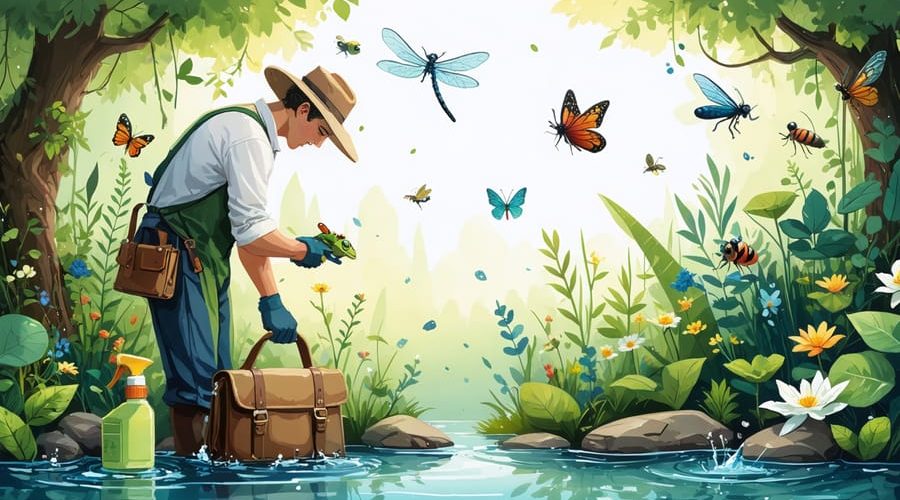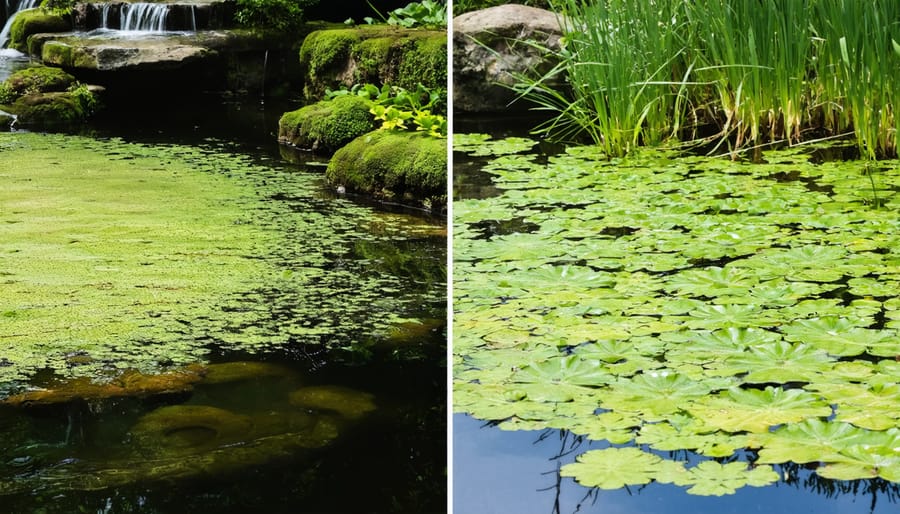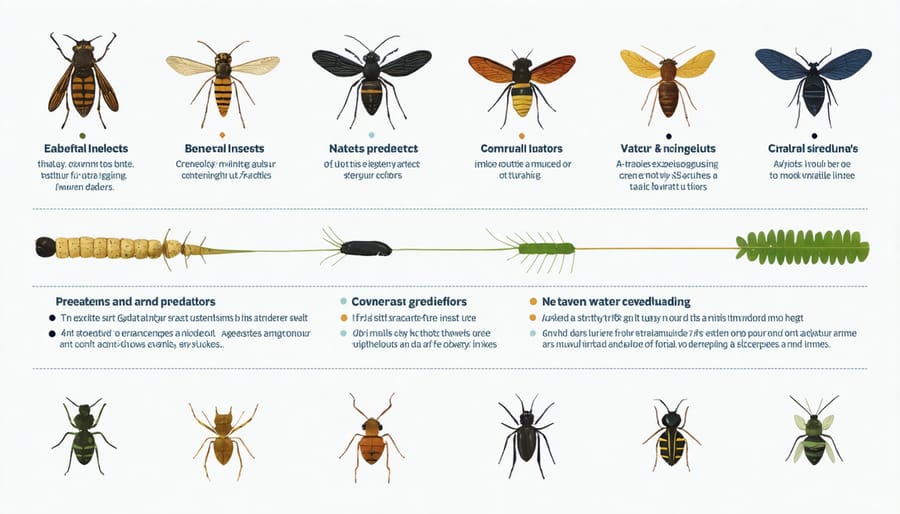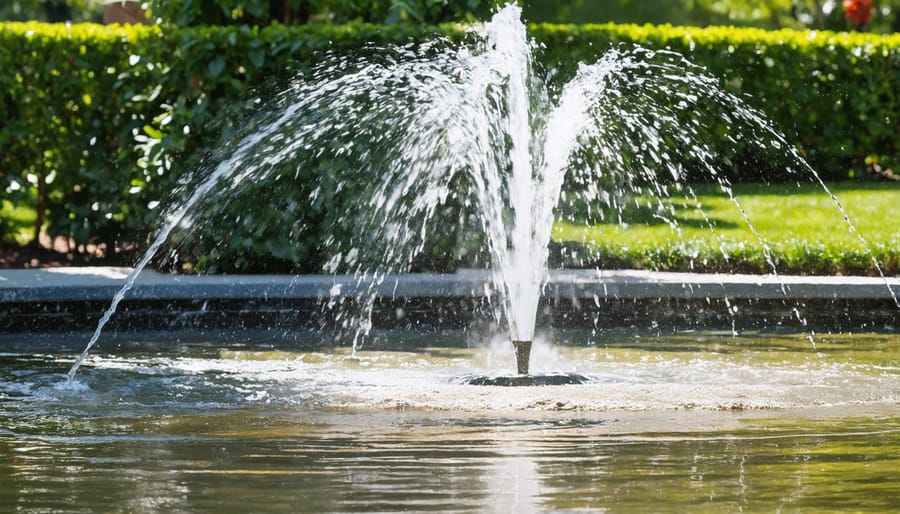
Yes, IPM Uses Pesticides – But Here’s How Water Gardens Are Different
Integrated Pest Management (IPM) strategically incorporates pesticides as just one tool within a comprehensive ecosystem-based approach to pest control. Rather than relying solely on chemical solutions, IPM practitioners first implement preventive measures, biological controls, and cultural practices to manage pest populations effectively. Pesticides serve as a last resort when other methods prove insufficient, and even then, they’re applied selectively and precisely to minimize environmental impact.
Think of IPM as a skilled gardener’s toolbox – while pesticides remain one of the tools available, they’re not the first choice for every job. Instead, IPM emphasizes monitoring pest levels, understanding pest life cycles, and maintaining healthy growing conditions that naturally discourage pest problems. This approach proves particularly valuable for home gardeners and agricultural professionals who want to protect their plants while preserving beneficial insects and maintaining ecological balance.
By combining careful observation, preventive strategies, and targeted interventions, IPM offers a more sustainable solution to pest management than traditional pesticide-dependent approaches. This method not only reduces chemical exposure but also proves more cost-effective and environmentally responsible in the long run, making it an increasingly popular choice for modern pest control.

The Role of Pesticides in Water Garden IPM
Chemical vs. Natural Pesticides
When it comes to pond care, choosing between chemical and natural pesticides requires careful consideration. While traditional chemical pesticides can be effective, they often pose risks to aquatic life and can disrupt the delicate ecosystem balance of your water garden. Many chemical pesticides can persist in water, potentially harming beneficial insects, fish, and plants.
Fortunately, there are many natural alternatives to pesticides that work effectively while being gentler on your pond environment. These include neem oil, insecticidal soaps, and beneficial bacteria products. Natural options typically break down more quickly and are less likely to accumulate in pond sediment or affect non-target organisms.
The key difference lies in their environmental impact. Chemical pesticides often provide faster results but can create long-term problems for pond health. Natural solutions, while sometimes requiring more frequent application, support a sustainable ecosystem approach. When incorporating either type into your IPM strategy, always start with the least toxic option first and follow proper application guidelines to protect your aquatic environment.
When Pesticides Become Necessary
While IPM emphasizes natural pest control methods, there are situations where pesticide use becomes necessary in water gardens. When pest populations reach damaging levels despite preventive measures, or when dealing with particularly aggressive invasive species, carefully selected pesticides can be an important last resort.
However, choosing pesticides for water gardens requires extra caution. Always opt for products specifically labeled as safe for aquatic environments and fish. Spot treatments are preferable to broad application, targeting only affected areas to minimize environmental impact. Consider timing as well – treating early in the morning or evening helps protect beneficial insects like bees.
Some scenarios that might warrant pesticide use include severe aphid infestations damaging water lilies, persistent mosquito larvae problems, or aggressive algae blooms that threaten fish health. Even then, start with the least toxic options first, such as insecticidal soaps or bacterial treatments specific to the pest.
Remember that any pesticide use should be temporary and part of a broader management strategy. Once the immediate threat is controlled, focus on strengthening preventive measures to avoid future reliance on chemical solutions.
IPM Prevention Strategies First
Biological Controls for Water Gardens
Water gardens naturally attract a variety of beneficial organisms that help keep pest populations in check. Dragonflies and damselflies are excellent mosquito controllers, with their larvae feeding on mosquito wrigglers beneath the water’s surface. Adding fish like koi and goldfish not only brings beauty to your pond but also helps control various aquatic insects and larvae.
Frogs and toads are particularly valuable allies, consuming numerous insects each night while adding charming nighttime sounds to your garden. Water beetles and backswimmers naturally colonize ponds and help maintain the ecological balance by feeding on mosquito larvae and other potential pests.
To encourage these natural pest controllers, maintain diverse plant life around your pond. Native marginal plants provide shelter and breeding grounds for helpful predators. Creating shallow areas and rock piles near the water’s edge offers perfect hideouts for frogs and beneficial insects.
Remember to be patient when establishing biological controls – it takes time for natural predator populations to build up. Once established, these helpful creatures form a sustainable pest management system that requires minimal intervention from you.

Cultural Controls
Cultural controls are the foundation of effective pest management, focusing on prevention rather than treatment. These practices make your garden naturally less attractive and hospitable to pests, reducing the need for chemical interventions. Simple steps like proper plant spacing allow better air circulation, which helps prevent fungal diseases and creates an environment where beneficial insects can thrive.
Maintaining healthy soil through regular composting and proper fertilization strengthens plants’ natural defenses against pests. Rotating crops annually disrupts pest life cycles and prevents them from establishing permanent populations. Good sanitation practices, such as removing dead plant material and keeping garden tools clean, eliminate potential pest breeding grounds.
Timing is crucial in cultural control. Planting at the right time of year ensures crops develop during periods when pest pressure is naturally lower. Strategic companion planting can confuse pests and attract beneficial insects that feed on harmful ones. For example, marigolds naturally repel certain nematodes, while herbs like dill and fennel attract predatory wasps that hunt caterpillars.
Remember, healthy plants are more resistant to pest problems, so focusing on proper watering, mulching, and general plant care forms the cornerstone of cultural pest control.
Safe Pesticide Application in Water Gardens
Choosing Aquatic-Safe Products
When selecting pest control products for your water garden, it’s crucial to choose options specifically labeled as safe for aquatic environments. Look for products that explicitly state they’re suitable for use around fish, aquatic plants, and beneficial insects. Natural alternatives like neem oil and insecticidal soaps can be effective when properly diluted, but always verify their safety for aquatic use.
Before applying any product, carefully read the label for specific instructions about application rates near water features. Some products may need to be applied at a certain distance from water edges or during particular times of day to minimize impact on aquatic life.
Consider the timing of your applications too. Early morning or evening treatments often work best, as beneficial insects are less active during these times. Always spot-treat problem areas rather than applying products broadly across your water garden.
Keep in mind that many conventional pesticides can be harmful to fish and other aquatic organisms, even in small amounts. When in doubt, consult with your local extension office or a water garden specialist who can recommend appropriate products for your specific situation. They can help you balance effective pest control with protecting your aquatic ecosystem.
Remember that prevention is often the best strategy – maintaining healthy water conditions and encouraging natural predators can reduce your need for chemical interventions.
Application Best Practices
When pesticides are necessary within an IPM program, timing and technique are crucial for effectiveness and safety. Always apply pesticides during dry, calm weather conditions to prevent drift and runoff. Early morning or late evening applications are ideal, as beneficial insects are less active during these times.
Start with spot treatments rather than broad applications, focusing only on affected areas. This targeted approach reduces environmental impact and preserves beneficial insects. Before applying any pesticide, properly identify the pest and ensure you’re using the right product at the correct concentration.
Remember to rotate between different types of pesticides to prevent resistance development. Keep detailed records of what you use, when you apply it, and the results. This information helps you refine your approach over time.
Personal protective equipment is non-negotiable – wear gloves, protective clothing, and appropriate respiratory protection when applying pesticides. Always read and follow label instructions carefully, paying special attention to waiting periods before harvesting crops or allowing people and pets back into treated areas.
Store pesticides in their original containers in a locked, well-ventilated area away from food, feed, and water sources. Dispose of empty containers according to local regulations to protect the environment and prevent accidental exposure.

Monitoring and Adjustment
Regular monitoring is the cornerstone of successful integrated pest management. Keep a simple garden journal to track pest populations, beneficial insects, and the effectiveness of your control methods. Take weekly walks through your garden, checking both sides of leaves and examining plant stems for signs of pest activity.
Document what you find, including the types of pests present, their numbers, and any plant damage. Photos can be especially helpful for tracking changes over time. Pay attention to weather patterns and seasonal changes, as these often influence pest activity.
If you’ve implemented control measures, assess their impact. Are pest numbers decreasing? Are your plants showing signs of recovery? This information helps you decide whether your current strategy is working or needs adjustment.
Don’t be afraid to modify your approach based on your observations. If natural predators aren’t keeping pests in check, you might need to introduce additional beneficial insects. If physical barriers aren’t working, consider adding companion plants that repel pests naturally.
When pesticides are part of your IPM strategy, carefully monitor their effectiveness and any potential impacts on beneficial insects. Sometimes reducing application frequency or switching to a different product might be necessary. Remember, the goal isn’t to eliminate all pests but to maintain them at acceptable levels while protecting your garden’s ecosystem.
Consider setting action thresholds – pest population levels at which you’ll implement different control measures. This helps avoid unnecessary interventions while ensuring timely response when needed.
In a well-maintained water garden, integrated pest management offers a balanced approach to pest control that doesn’t rely solely on pesticides. While chemical treatments can play a role, they should be your last resort after trying natural solutions and preventive measures. Remember to always choose aquatic-safe products, apply them precisely according to instructions, and consider the delicate ecosystem of your water feature. By combining cultural controls, biological solutions, and careful monitoring with selective pesticide use only when necessary, you can create a thriving, healthy water garden that naturally resists pest problems. This responsible approach protects not just your plants, but also beneficial insects, fish, and the overall environment while still effectively managing unwanted pests.
